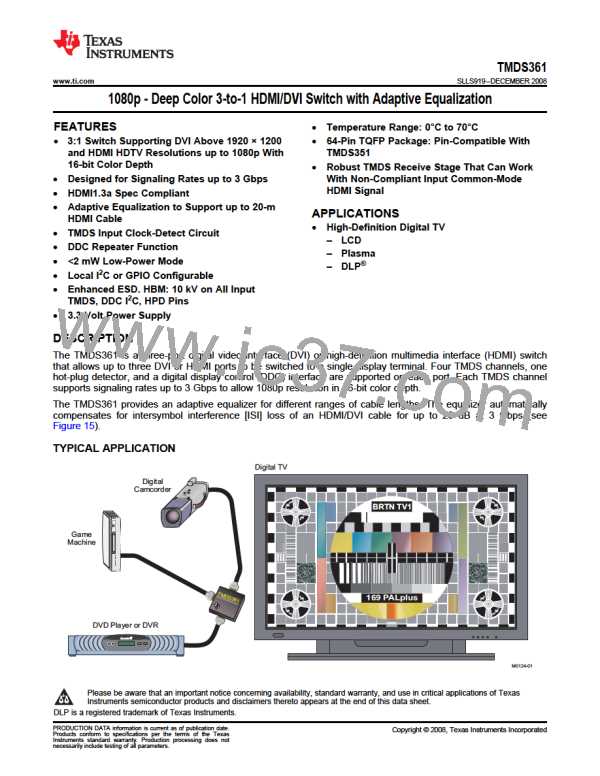TMDS361
SLLS919–DECEMBER 2008............................................................................................................................................................................................ www.ti.com
These devices have limited built-in ESD protection. The leads should be shorted together or the device placed in conductive foam
during storage or handling to prevent electrostatic damage to the MOS gates.
DESCRIPTION (CONTINUED)
When any of the input ports are selected, the integrated terminations (50-Ω termination resistors pulled up to
VCC) are switched on for the TMDS clock channel, the TMDS clock-detection circuit is enabled, and the DDC
repeater is enabled. After a valid TMDS clock is detected, the integrated termination resistors for the data lines
are enabled, and the output TMDS lines are enabled. When an input port is not selected, the integrated
terminations are switched off, the TMDS receivers are disabled, and the DDC repeater is disabled.
Clock-detection circuitry provides an automatic power-management feature, because if no valid TMDS clock is
detected, the terminations on the input TMDS data lines are disconnected and the TMDS outputs are placed in a
high-impedance state.
The TMDS361 is designed to be controlled via a local I2C interface or GPIO interface based on the status of the
I2C_SEL pin. The local I2C interface in TMDS361 is a slave-only I2C interface. (See the I2C INTERFACE
NOTES section.)
I2C Mode: When the I2C_SEL pin is set low, the device is in I2C mode. With local I2C, the interface port status
can be read and the advanced configurations of the device such as TMDS output edge rate control, DDC I2C
buffer output-voltage-select (OVS) settings (See the DDC I2C Function Description for detailed description on
DDC I2C buffer description and OVS description), device power management, TMDS clock-detect feature and
TMDS input-port selection can be set. See Table 8 through Table 11.
GPIO mode: When the I2C_SEL pin is set high, the device is in GPIO control mode. The port selection is
controlled with source selectors, S1 and S2. The power-saving mode is controlled through the LP pin. In GPIO
mode, the default TMDS output edge rate that is the fastest setting of rise and fall time is set, and the default
DDC I2C buffer OVS setting (OVS3) is set. See Table 8 and the DDC I2C Function Description for detailed
description of the DDC I2C buffer.
Following are some of the key features (advantages) that TMDS361 provides to the overall sink-side system
(HDTV).
•
•
3×1 switch that supports TMDS data rates up to 3 Gbps on all three input ports.
ESD: Built-in support for high ESD protection (up to 10 kV on the HDMI source side). The HDMI source-side
pins on the TMDS361 are connected via the HDMI/DVI exterior connectors and cable to the HDMI/DVI
sources (e.g., DVD player). In TV applications, it can be expected that the source side may be subjected to
higher ESD stresses compared to the sink side that is connected internally to the HDMI receiver.
•
•
Adaptive equalization: The built-in adaptive equalization support compensates for intersymbol interference
[ISI] loss of up to 20 dB, which represents a typical 20-m HDMI/DVI cable at 3 Gbps. Adaptive equalization
adjusts the equalization gain automatically, based on the cable length and the incoming TMDS data rate.
TMDS clock-detect circuitry: This feature provides an automatic power-management feature and also ensures
that the TMDS output port is turned on only if there is a valid TMDS input signal. TMDS clock-detect feature
can be by-passed in I2C Mode, See Table 10 and Table 11. It is recommended that TMDS361 is used in this
default mode during normal functional operation where clock detect circuit is enabled . However for HDMI
compliance testing (TMDS Termination Voltage Test) Clock detect feature can be bypassed.
DDC I2C buffer: This feature provides isolation on the source side and sink side DDC I2C capacitance, thus
helping the sink system to pass system-level compliance.
•
•
Robust TMDS receive stage: This feature ensures that the TMDS361 can work with TMDS input signals
having common-mode voltage levels that can be either compliant or non-compliant with HDMI/DVI
specifications.
•
VSadj: This feature adjusts the TMDS output swing and can help the sink system to tune the output TMDS
swing of the TMDS361 (if needed) based on the system requirements.
•
•
GPIO or local I2C interface to control the device features
TMDS output edge-rate control: This feature adjusts the TMDS361 TMDS output rise and fall times. There
are four settings of the rise and fall times that can be chosen. The default setting is the fastest rise and fall
time; the other three settings are slower. Slower edge transitions can potentially help the sink system (HDTV)
in passing regulatory EMI compliance.
2
Submit Documentation Feedback
Copyright © 2008, Texas Instruments Incorporated
Product Folder Link(s) :TMDS361

 TI [ TEXAS INSTRUMENTS ]
TI [ TEXAS INSTRUMENTS ]